#boeing 737 max 8
Explore tagged Tumblr posts
Text
Going on my first flight by myself soon!
its on the boeing 737 max 8! (Yes this was one of the ones with all the problems) What should I bring chat
63 notes
·
View notes
Text
Navigating the Skies: Akasa Air's Boeing 737 MAX Fleet
Introduction:
In the ever-evolving world of aviation, Akasa Air has emerged as a dynamic player, harnessing the power of cutting-edge technology to redefine air travel. At the heart of their strategy lies the Boeing 737 MAX series, with the MAX 8 currently in operation and the eagerly anticipated addition of the MAX 10 to their fleet. This comprehensive exploration delves into Akasa Air's utilization of the Boeing 737 MAX series, from its inception to its future prospects.
The Boeing 737 MAX:
A Revolution in Air Travel The Boeing 737 MAX series represents a quantum leap in aircraft design, incorporating advanced technology to enhance performance, efficiency, and passenger comfort. With variants like the MAX 8 and MAX 10, Boeing offers airlines like Akasa Air unparalleled versatility to meet diverse operational needs.
Akasa Air's Strategic Fleet Expansion For Akasa Air, the decision to embrace the Boeing 737 MAX series aligns with its commitment to excellence and innovation. The MAX 8, renowned for its fuel efficiency and range, has become a cornerstone of Akasa Air's fleet, enabling the airline to optimize its operations and offer passengers a superior travel experience.
The Boeing 737 MAX 8:
Engineered for Success As Akasa Air's workhorse, the Boeing 737 MAX 8 exemplifies the epitome of modern aviation. With its advanced aerodynamics and state-of-the-art LEAP engines, the MAX 8 delivers unmatched fuel efficiency and operational reliability, allowing Akasa Air to streamline its operations and reduce environmental impact.
Safety Challenges and Regulatory Compliance The Boeing 737 MAX series faced unprecedented scrutiny following tragic accidents attributed to the MCAS system. In response, Boeing implemented rigorous modifications and collaborated closely with regulatory authorities to ensure the aircraft's safe return to service. Akasa Air remained steadfast in its commitment to safety, implementing comprehensive training programs and adhering to stringent regulatory guidelines.
Restoring Passenger Confidence Central to Akasa Air's success is the trust and confidence of its passengers. In the aftermath of the Boeing 737 MAX grounding, the airline prioritized transparency and communication to reassure travelers of the aircraft's safety. By providing accurate information and implementing robust safety measures, Akasa Air reaffirmed its dedication to passenger well-being.
The Arrival of the Boeing 737 MAX 10 With the impending introduction of the Boeing 737 MAX 10, Akasa Air anticipates unlocking new possibilities for growth and expansion. The MAX 10's increased seating capacity and extended range offer the airline enhanced operational flexibility, enabling it to serve new markets and routes with greater efficiency.
Elevating the Passenger Experience Beyond performance and efficiency, the Boeing 737 MAX series enhances the passenger experience with its spacious cabin design, advanced entertainment systems, and ergonomic seating. Akasa Air leverages these features to create a comfortable and enjoyable journey for its discerning travelers, setting new standards for in-flight comfort.
Sustainability and Environmental Responsibility As environmental sustainability takes center stage in the aviation industry, the Boeing 737 MAX's fuel-efficient engines and reduced emissions align perfectly with Akasa Air's commitment to environmental stewardship. By operating these eco-friendly aircraft, the airline not only minimizes its carbon footprint but also sets an example for responsible aviation practices.
Conclusion:
Charting a Course for Success In conclusion, Akasa Air's embrace of the Boeing 737 MAX 10 series exemplifies its forward-thinking approach to aviation. By leveraging the MAX 8 and eagerly anticipating the arrival of the MAX 10, the airline positions itself for sustained growth, operational excellence, and unparalleled passenger satisfaction. As Akasa Air continues to navigate the skies, its Boeing 737 MAX fleet serves as a beacon of innovation and a testament to the limitless possibilities of modern air travel.
0 notes
Text
0 notes
Text

0 notes
Text
Trying to follow the news today
Like watching a train derail and slam into a petrol station
#On a scale of 'disney after mulan 2020' to 'boeing after the 737 max 8'#How badly has the ebu fucked up#Eurovision
50 notes
·
View notes
Text

Boeing's 737 MAX 8 demo at Farnborough 2016
9 notes
·
View notes
Text
Boeing Whistleblower Continues to Raise Concerns
At the National Whistleblower Day celebration held on Capitol Hill on July 30, a Boeing whistleblower announced new documents which he claims further demonstrate shortcomings by Boeing around the manufacturing of the 737 Max which crashed in Ethiopia on March 10, 2019. During his speech, Ed Pierson, the Executive Director of The Foundation for Aviation Safety, an aviation industry watchdog group,…
#737 Max#Boeing#Electrical Systems Responsibility Center#ESRC#Ethiopian Airlines 737-8 MAX#FAA#Federal Aviation Administration#Foundation for Aviation Safety#National Whistleblower Day#watchdog#Whistleblower
0 notes
Text
What Has Happened to Boeing Since the 737 Max Crashes
— By Priyanka Boghani and Kaela Malig | March 13, 2024
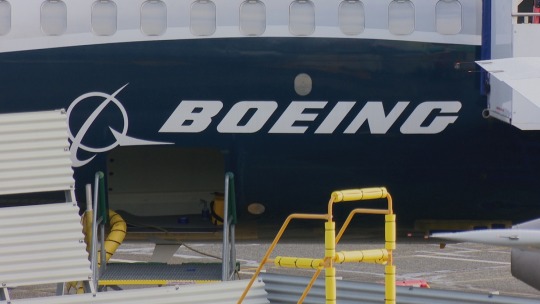
A still from "Boeing's Fatal Flaw," a new FRONTLINE Documentary with The New York Times.
Five years ago, 346 people were killed in two crashes involving Boeing 737 Max planes within the span of almost five months: first off the coast of Indonesia in October 2018 and then in Ethiopia in March 2019.
Boeing’s Fatal Flaw, a 2021 FRONTLINE investigation with The New York Times, examined how commercial pressures, flawed design and failed oversight contributed to those devastating tragedies and a catastrophic crisis at one of the world’s most iconic industrial names.
In recent months, Boeing has come under renewed scrutiny after a door-like panel on a Boeing 737 Max 9 operated by Alaska Airlines blew off just a few minutes after takeoff in January 2024. An updated version of our documentary examines the impact of this latest crisis.
“This was supposed to be one of the most highly scrutinized planes in the world. And here you are with another incident that was risking passengers’ lives,” the Times’ Sydney Ember says in the updated documentary.
Here we take a brief look at what has happened to Boeing since the deadly 2018 and 2019 crashes and the recent Alaska Airlines incident.
Change in Leadership
Dennis Muilenburg had been CEO of Boeing since 2015. In the aftermath of the crashes, he testified before U.S. Senate and House Committees in October 2019, acknowledging the fatal accidents happened “on my watch” and saying he and the company were accountable. He told the House Committee on Transportation and Infrastructure, “If we knew back then what we know now, we would have grounded [the 737 Max] right after the first accident.”
Two months after the congressional hearings, on Dec. 23, 2019, Muilenburg was fired by Boeing. The company described the move as “necessary to restore confidence” in Boeing “as it works to repair relationships with regulators, customers, and all other stakeholders.”
David Calhoun stepped into the role of CEO in January 2020 and continues to fill the position.
A $2.5 Billion DOJ Settlement and Challenges
On Jan. 7, 2021, the Department of Justice announced that Boeing would pay a $2.5 billion settlement, resolving a DOJ charge that the company had conspired to defraud the Federal Aviation Administration’s Aircraft Evaluation Group.
The DOJ’s criminal investigation focused on the actions of two employees who Boeing said in court documents “deceived the FAA AEG” about the Maneuvering Characteristics Augmentation System (MCAS) onboard the 737 Max — a system the DOJ said “may have played a role” in both 737 Max crashes. The DOJ said the employees’ “deception” led to information about MCAS being left out of a key document released by the FAA, as well as airplane manuals and pilot-training materials.
As Boeing’s Fatal Flaw recounts, congressional investigators found internal documents showing that, after Boeing realized the impact MCAS would have on pilot training and FAA certification, some Boeing employees suggested removing all references to MCAS from training manuals.
“Boeing’s employees chose the path of profit over candor by concealing material information from the FAA concerning the operation of its 737 Max airplane and engaging in an effort to cover up their deception,” said David P. Burns, the acting assistant attorney general of the DOJ’s criminal division when the settlement was announced.
The company entered into a deferred prosecution agreement with the DOJ, in which Boeing agreed to pay a nearly $244 million fine, to set up a $500-million fund for the families of people who died in the two crashes, and to pay $1.77 billion to airlines that had been affected by the 20-month grounding of the 737 Max that began in March 2019.
Boeing also agreed to continue cooperating with the DOJ’s Fraud Section on “any ongoing or future investigations and prosecutions” and is required to report any alleged violation of fraud laws by Boeing employees when dealing with foreign or domestic agencies, regulators or airline customers.
Boeing declined FRONTLINE’s request to be interviewed for the documentary. In a statement, the company said safety is its top priority and it has worked closely with regulators, investigators and stakeholders “to implement changes that ensure accidents like these never happen again.”
Former Boeing Pilot Found Not Guilty for Fraud
In October 2021, a federal grand jury criminally indicted Mark Forkner, Boeing’s Former Chief Technical Pilot for the 737 Max Airplane, on fraud charges. Forkner, who became the first and so far only individual to face criminal charges after the two fatal crashes, was accused of providing “materially false, inaccurate and incomplete information” to FAA regulators about flight-control software involved in the 2018 and 2019 crashes. Forkner was later found not guilty of all charges in federal court.
Forkner declined to be interviewed for the documentary, but his lawyer told the Times that his communications with the FAA were honest and that “he would never jeopardize the safety of other pilots or their passengers.”
Lawsuits by Families of Crash Victims
By November 2019, Boeing was facing more than 150 lawsuits filed by families of people who had died in the two crashes — over 50 of the suits stemming from the Indonesian crash and about 100 from the crash in Ethiopia, according to the Associated Press’ review of federal court records.
In July 2020, Boeing told a U.S. federal court that claims related to 171 of the 189 people killed in the Indonesia crash were either partially or fully settled, although the settlements were not publicly disclosed.
As of June 2023, cases related to 68 passengers from the Ethiopian Airlines crash were pending.
The Grounding and Return of the 737 Max 8 and Max 9
In the days after the second 737 Max crashed in March 2019, regulators around the world — from China to the European Union and several other countries — grounded the plane. The U.S. Federal Aviation Administration followed suit on March 13, 2019, after initially saying the planes were safe to fly.
When the FAA retested and approved the 737 Max 8 and Max 9, ending the grounding in November 2020, it required airlines to take the following steps before putting the planes back into service: installing new flight-control-computer and display-system software; incorporating revised flight-crew procedures; rerouting wiring; completing a test of the “angle of attack” sensor system, which had contributed to both the 2018 and 2019 crashes; and performing an operational readiness flight.
The FAA, in conjunction with aviation agencies from Canada, Brazil and the European Union, also concluded that pilots operating the 737 Max would need to complete special training. It is not clear who would pay for this additional training, which reversed one of Boeing’s original sales pitches to airlines for the 737 Max: that the plane would require minimal pilot training.
A December 2020 Senate committee report criticized Boeing and the FAA’s handling of the 737 Max recertification testing, saying that, based on whistleblower information and testimony, it appeared Boeing and FAA officials had “established a pre-determined outcome,” and that Boeing officials “inappropriately coached” test pilots in the MCAS simulator. The report alleged, “It appears, in this instance, FAA and Boeing were attempting to cover up important information that may have contributed to the 737 MAX tragedies.”
The FAA responded at the time, saying: “Working closely with other international regulators, the FAA conducted a thorough and deliberate review of the 737 Max.” The agency added it was “confident” the issues that led to the two crashes had been “addressed through the design changes required and independently approved by the FAA and its partners.”
“We have learned many hard lessons” from the crashes, Boeing said in its own statement at the time. The company said it took the committee’s findings seriously and would continue to review the report in full.
Following the Senate report, families of the 2019 Ethiopian crash victims wrote to the FAA and the U.S. Department of Transportation in a letter dated Dec. 22, 2020, and reviewed by Reuters, asking for the 737 Max approval to be rescinded and for an investigation to “determine whether the MAX recertification process was tainted.”
A Brazilian airline was the first to fly a 737 Max after regulators there followed the FAA in ungrounding the plane. On Dec. 29, 2020 — a week after the families’ letter — the 737 Max flew paying passengers in America for the first time after nearly two years of being grounded. A month later, Europe’s aviation authority also gave the 737 Max clearance to fly.
On Aug. 26, 2021, India lifted its ban on the 737 Max after “closely” monitoring the plane’s performance elsewhere and noting “no untoward reporting.” China, which was the first country to ground Max jets after the deadly crashes, resumed commercial flights with the model in January 2023.
The 737 Max 10
On June 18, 2021, Boeing’s new model 737 Max 10 took to the skies for its first flight. The Max 10 is larger than the Max 8, which was involved in the 2018 and 2019 crashes, and the Max 9. According to Boeing’s technical specs, the Max 10 is 14 feet longer than the Max 8 and can seat a maximum of 230 people, compared to the Max 8’s capacity of 210.
At the time of the test flight, Boeing was already working on additional safety features in the Max 10 requested by European regulators, according to Reuters.
“We’re going to take our time on this certification,” Stan Deal, who became president and CEO of Boeing’s Commercial Airplanes division in October 2019, said at the time of the Max 10’s first flight, according to The Seattle Times. “We’re committed to make further safety enhancements.”’
The FAA cleared the Max 10 to begin test flights, a step towards certification, last November.
Alaska Airlines Plane Incident
On January 5, an Alaska Airlines jet made an emergency landing in Portland, Oregon, after a portion of its fuselage blew out and left a door-sized hole in the side of the aircraft while it was around 16,000 feet in the sky. None of the 171 passengers and six crew members were seriously injured. The FAA temporarily grounded more than 170 Max 9 jets so they could be inspected.
In the aftermath, Boeing CEO David Calhoun has said, “Boeing is accountable for what happened.”
A Feb. 6 preliminary report from the National Transportation Safety Board said that the bolts meant to secure the door-like panel appeared to be missing before the flight.
Later the same month, the FAA released a long-awaited report that found that Boeing’s safety culture has been “inadequate” and “confusing.” The FAA gave Boeing 90 days to come up with a plan to address quality control issues.
The FAA conducted a six-week audit after the Alaska Airlines incident, and on March 4 said that it found Boeing had allegedly failed to comply with manufacturing quality control requirements.
Boeing now faces legal trouble in relation to the Jan. 5 event, including lawsuits filed by passengers and shareholders.
On Feb. 21, Boeing told employees that Ed Clark, who led the 737 program since 2021, would be replaced. The memo announcing Clark’s departure and other changes said the company was focused “on ensuring that every airplane we deliver meets or exceeds all quality and safety requirements.”
The Justice Department has also begun a criminal investigation into Boeing in the aftermath of the Alaska Airlines incident, as reported first by The Wall Street Journal.
“Cultural change doesn’t happen overnight, especially at big corporations like this,” David Gelles, one of the Times reporters featured in Boeing’s Fatal Flaw, says. “If Boeing wants to get back to that place of grandeur where it was for so long one of the most important American companies, it’s going to take not four years, but it might take 14.”
#Boeing#Frontline#737 Max Crashes#Priyanka Boghani and Kaela Malig#Leadership#A $2.5 Billion DOJ Settlement#Mark Forkner | Boeing’s Former Chief Technical Pilot | 737 Max Airplane#Lawsuits By Families#Grounding | Returning | 737 Max 8 | 737 Max 9#737 Max 10#Alaska Airlines | Plane Incident#Boeing’s Fatal Flaws#The New York Times#U.S. Senate and House Committees#House Committee on Transportation and Infrastructure#Dennis Muilenburg | CEO of Boeing | Fired#New CEO | Boeing | David Calhoun#Maneuvering Characteristics Augmentation System (MCAS)#150 Lawsuits Filed By families | 50 By Indonesian Families#MCAS Simulator
0 notes
Text
https://concordenickartphoto.zenfolio.com/p712887504/ea07989ac
#aviation#concordenick artphoto#aircraft#airplane#concordenickartphoto.zenfolio.com#transport#flight#travel#aviation photography#flying#Boeing#Air Canada#B-737#B-737-8 MAX
1 note
·
View note
Note
Trick or treat!
You get:

Boeing 737 MAX 8
14 notes
·
View notes
Note
That one image thats Tails in a plane’s gear bay
Do you happen to know the model? Cause it reminds me of a 737 Max 8, but i could be wrong
HAHA! you're right!! it is a boeing 737 max 8 :D!!!
i even said so in the tweet when i posted it, but i didnt on tumblr

i even had someone send me pics of the gear bay she worked on before because she was impressed that she could reconized it
it made me so happpyyyy im still living that high, altough it's not like i did it out of memory, i had refferences with me thru the entire proccess
15 notes
·
View notes
Text
Wishing I could bring my skirt on the plane
IT WOULD BE SO COMFORTABLE AND RAD.... But my parents are picking me up and I don't think ill have time anywhere to change ):
#skirt#trans#transgirl#transgender#trans pide#transfem#plane#planes#flight#first solo flight#boeing#boeing 737#boeing 737 max 8
21 notes
·
View notes
Text
A Closer Look at Akasa Air's Boeing 737 MAX Fleet
Introduction:
Akasa Air, one of the emerging players in the aviation industry, has made significant strides with its modern fleet, prominently featuring the Boeing 737 MAX series. In particular, the airline has embraced the Boeing 737 MAX 8 and eagerly awaits the integration of the Boeing 737 MAX 10 into its operations. This article delves into the significance of these aircraft for Akasa Air, exploring their features, controversies, and the airline's strategy for leveraging them.
Evolution of the Boeing 737 MAX:
The Boeing 737 MAX series represents a new era in aviation, with advanced technology aimed at enhancing fuel efficiency, range, and passenger comfort. The MAX 8, MAX 9, and MAX 10 variants offer airlines flexibility in configuring seating capacities while maintaining operational efficiency.
Akasa Air's Fleet Strategy:
Akasa Air's decision to incorporate the Boeing 737 MAX series into its fleet aligns with its vision of modernizing operations and enhancing passenger experience. The airline's emphasis on fuel efficiency and cost-effectiveness makes the MAX series an ideal choice for its domestic and international routes.
Boeing 737 MAX 8:
Cornerstone of Akasa Air's Fleet: The Boeing 737 MAX 8 serves as the cornerstone of Akasa Air's fleet, offering a balance of range and capacity suitable for its diverse route network. With its advanced aerodynamics and fuel-efficient engines, the MAX 8 enables Akasa Air to operate economically while reducing its carbon footprint.
Safety Concerns and Regulatory Challenges:
The Boeing 737 MAX series faced unprecedented scrutiny following two fatal accidents attributed to the Maneuvering Characteristics Augmentation System (MCAS). Consequently, global regulators grounded the aircraft, leading to extensive modifications and recertification processes. Akasa Air, like other operators, navigated through these challenges, prioritizing safety and compliance.
Restoring Confidence:
Boeing 737 MAX 10 in Akasa Air's Approach:
Amidst the safety concerns surrounding the Boeing 737 MAX, Akasa Air adopted a proactive approach to reassure passengers and stakeholders. The airline implemented comprehensive training programs for pilots, emphasized transparent communication, and collaborated closely with regulatory authorities to ensure adherence to safety protocols.
Integration of the Boeing 737 MAX 10:
Akasa Air eagerly anticipates the integration of the Boeing 737 MAX 10 into its fleet, recognizing its potential to further optimize operational efficiency and enhance passenger comfort. With its increased seating capacity and extended range, the MAX 10 opens up new possibilities for the airline's route expansion plans.
Passenger Experience and Comfort:
In addition to operational advantages, the Boeing 737 MAX series offers passengers a modern and comfortable travel experience. Enhanced cabin features, such as larger windows, mood lighting, and spacious overhead bins, contribute to a pleasant journey for Akasa Air's discerning travelers.
Environmental Sustainability:
As sustainability becomes increasingly important in the aviation industry, the Boeing 737 MAX's fuel efficiency and reduced emissions align with Akasa Air's commitment to environmental stewardship. By operating these aircraft, the airline demonstrates its dedication to minimizing its carbon footprint and contributing to a greener future.
Conclusion:
Akasa Air's investment in the Boeing 737 MAX series underscores its commitment to innovation, safety, and passenger satisfaction. Despite initial challenges, the airline remains optimistic about the future of its MAX fleet, leveraging these state-of-the-art aircraft to solidify its position in the competitive aviation market while prioritizing safety and sustainability.

In summary, the Boeing 737 MAX, particularly the MAX 8 and the upcoming MAX 10, plays a pivotal role in Akasa Air's growth strategy, offering a blend of efficiency, reliability, and passenger comfort that aligns with the airline's vision for the future of air travel.
0 notes
Text
Aus der Reihe "Unnützes Spatort-Wissen"
Die "private Maschine" ist dieses Flugzeug: Eine Boeing 737 Max 8, zum Zeitpunkt der Dreharbeiten geleased von der Charterfluggesellschaft SmartLynx Malta, momentan geleased von der türkischen Billigfluggesellschaft Anadolujet. Vermutlich "gecastet" weil es damals keine auffälligen Aufschriften hatte.
Fliegt momentan laut Flightradar24 für Turkish Airlines von Köln, Hannover, Stuttgart und Brüssel nach Istanbul. Bitte keine Sporttasche voller Geld mit an Bord nehmen.
47 notes
·
View notes
Text
Hi and welcome to another episode of Nerd Knowlege with Kari!
In this episode we'll be talking about the Boeing 737 MAX 8, the MCAS system and why said system was even installed, why it failed.
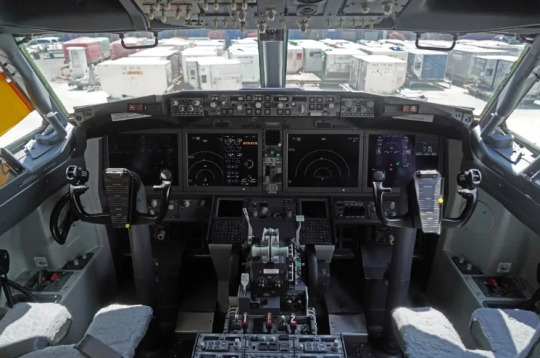
(this ist the actual Cockpit of a 737 max 8)
One lovely day someone at Boeing woke up, saw that Airbus (the Europen counterpart) had decided to renew its engines, and went: "Oh shit we have to do that too". And they did, just not well.
The Boeing 737 Max 8 failed 33 out of 89 tests, which is a lot.
With a too-high AoA (angle of attack) at take-off caused by the weight of the new engines, they could lead to possible danger.
So Boeing decided that a system that corrects the aeroplanes nose if needed. And so the MCAS ( or Maneuvering Characteristics Augmentation system [say that 5 times in a row I dare you]).
One would argue that pilots would need proper training for a new system, but not Boeing. Why?
Because it's cheaper to give pilots a one to two-hour iPad course. And I'm not even joking, that is literally the training they got.
Now what made it fail?
The MCAS system relied on one single sensor, and that sensor gave wrong AoA data, causing the system to automatically push the nose downwards.
The pilots could push up the nose as much as they wanted, the system would always push it back down. The pilots did not know how to fix this problem which then led to two horrible crashes.
I would like to add that having the finance guys take over the company was a bad decision.
I hope you're doing good!
Logging off,
Kari
[20/07/2024]
#nerdknowledgewithkari🪷#aviation#aerodynamics#aeroplane#airplane#boeing#airbus#planes#aircraft#flying#aerospace#airplanes#nerd#mcas#software
14 notes
·
View notes
Note
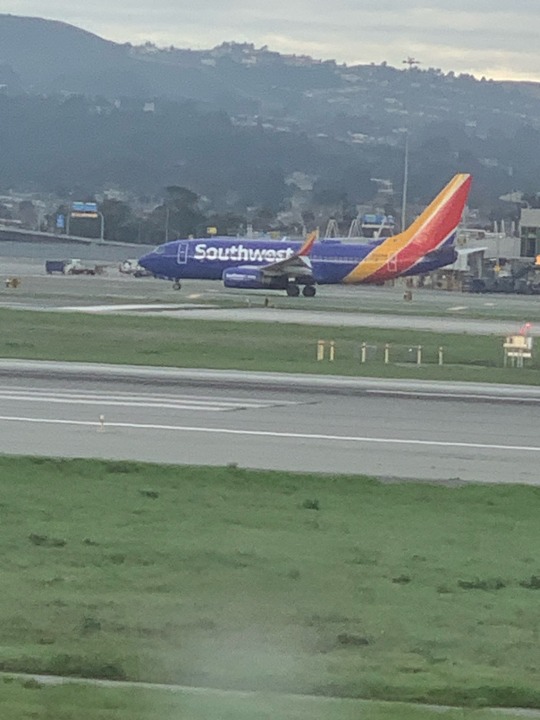
i thought southwest was all 737s?? why does she look so stubby???
Southwest is all 737s, yes! It's wild how quickly the 737's reputation has changed because they used to be The stubby plane.
There are four 'generations' of 737 - original (100/200), Classic (300/400/500), Next Generation (600/700/800/900), and MAX (8M/9M/7M and 10M when those enter service). The first 737 model from all the way back in the 60s, the -100, looked like This:
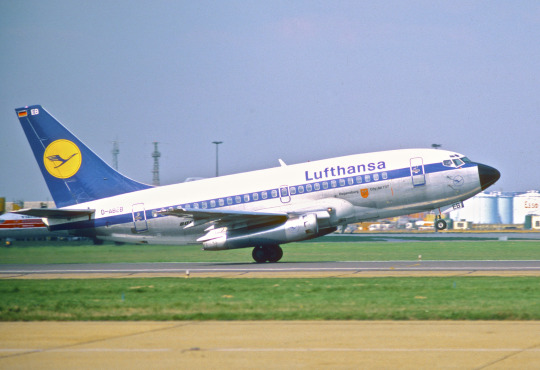
(They only made 30 of them and they were basically all Lufthansa's, but I think NASA might still have one)
Because, you see, the 737 was intended to be strictly a short-range jet carrying small amounts of passengers and because of that it was absolutely teeny. It was actually meant to compete with planes as small as the Fokker F28, and in modern terms I'd compare it to something like an A318 or E170 (except far more limited in range). Original 737s operated routes you'd probably use props for today. They were literally made to take over on routes too small and low-capacity for the 727.
(Check out those weird stretched out nacelles - those are JT8Ds, and they're most prominently also used on the DC-9 but you can also find them on some 727s, some Caravelles, and one of my favorite obscure failed airliners, the Dassault Mercure. Get a long, little engine, they said. You can tell original 737s apart from Classics because those ones have regular(ish) engines.)
Then for some reason Boeing just kept stretching her?


737-200 of United Airlines | 737-300 (Classic) of LOT Polish Airlines
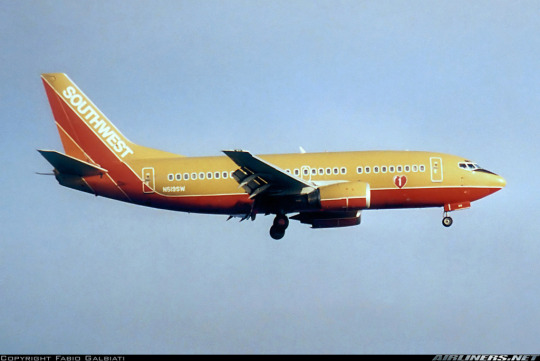
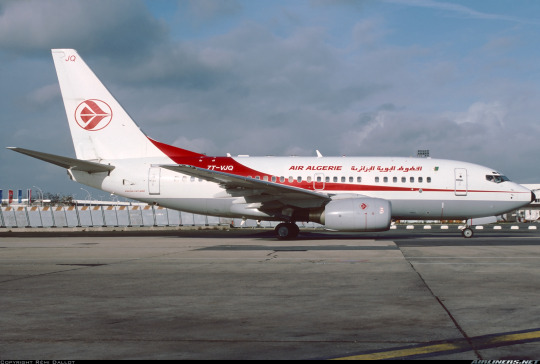
737-500 (Classic) of Southwest Airlines | 737-600 (Classic) of Air Algérie
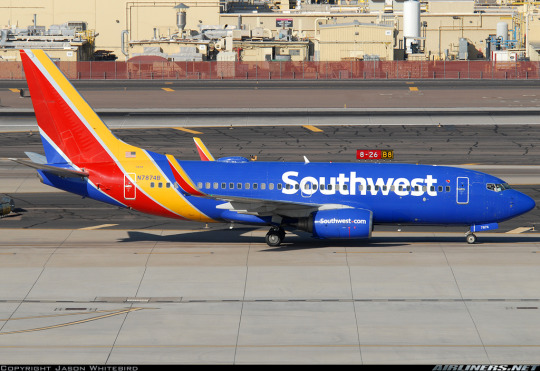
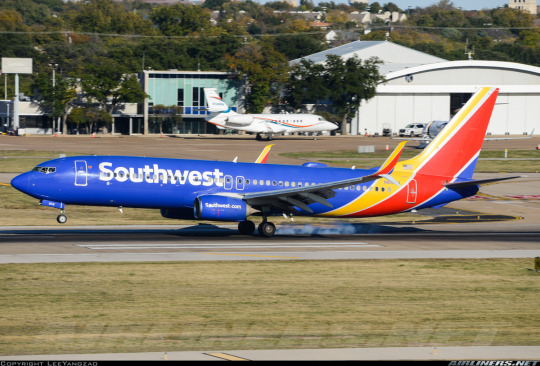
737-700 (NG) of Southwest Airlines | 737-800 (NG) of Southwest Airlines
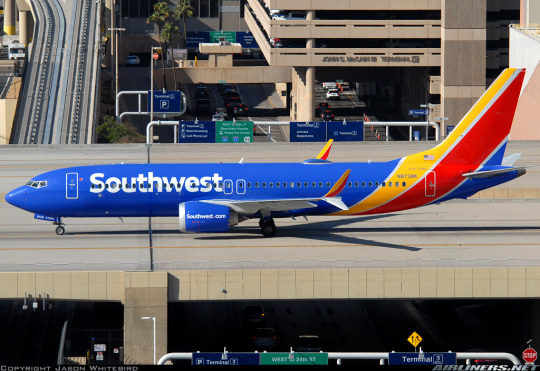
737 MAX 8 of Southwest Airlines
And now they're comparable to 757s, for some reason. I have a massive soft spot for the old stubby 737s. To me that's what a 737 is supposed to be. But the -800 was the most produced until the MAX 8, which I believe has similar numbers, so those are what people are most used to seeing if they grew up after the 727 era.
As for Southwest, they operated the 200, 300, and 500, and right now they operate the 700, 800, and MAX 8. They're planning to replace the 700s with MAX 7s, but those aren't getting built yet...so you got to see the 700, which, despite all the stretching, manages to hold onto some of the stubby glory the 800 and MAX lost. I think the Southwest livery looks extra good on her because of it 😊
27 notes
·
View notes